Project Logistics: The Basics of Anything But Basic
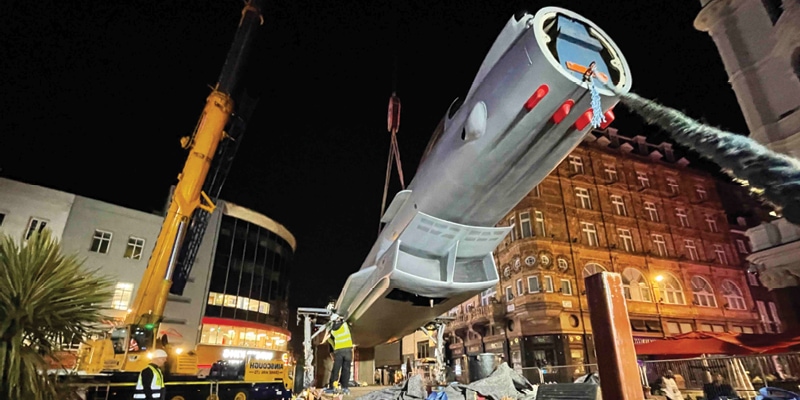
Moving big, bulky, unconventional freight around the globe precisely and effectively in the face of myriad challenges is not for the faint of heart. Here’s how project logistics experts get it done.
It’s not every day in transportation and logistics that you are involved in a star-studded movie premiere with both Hollywood royalty and actual members of the British monarchy in attendance. But that was the reality recently for the project logistics team at CEVA Logistics, which played a key role in the London premier of the new Top Gun movie. On the red carpet, along with leading man Tom Cruise, other cast members, and the Duke and Duchess of Cambridge, sat a full-scale replica of the Typhoon fighter jet used in the film.
Getting the jet delivered and assembled for the premiere—and removing it once the lights, camera, and action of the big night were finished—was a maverick move, according to Sharon Robinson, managing director for CEVA Logistics’ Showfreight division, which oversaw the project.
The Typhoon was a full-scale replica, accurate in all details to a flying Typhoon, and was shipped from Farnborough in Hampshire (its full-time storage location) to Leicester Square in central London.
“The replica was shipped dismantled as one oversized low/wide load with two support trailers carrying the undercarriage, wings, and tail, as well as our tools and equipment needed for the construction,” she explains.
Robinson’s team had just seven hours to unload and install the scale model for its client, BAE Systems, which produces the real-world aircraft. And, by 6:00 the next morning, the replica aircraft and all its associated equipment had to be dismantled and transported away.
Having supported BAE Systems with other similar projects for some 20 years, the CEVA team had the right experience to handle this project logistics move seamlessly. “The key to the project was the accuracy of information supplied to the event organizers prior to the event so that a precise plan could be set out for all contractors to work safely together in a time-critical manner,” Robinson notes.
While most project cargo moves are not quite as high-profile as the Top Gun project, they happen successfully all over the world, every day, thanks to a similar mix of experienced personnel, intense coordination and planning, and savvy use of logistics technology.
Project logistics—also known as bulk logistics—involves planning, organizing, managing, processing, and controlling the complete flow of goods, materials, and information associated with the successful completion of a specific project. The freight involved is typically large, bulky, heavy, unusually shaped, and high-value, making project logistics one of the most demanding areas of supply chain, logistics, and transportation.
Typically, bulk shippers operate in verticals such as oil and gas, energy, mining, construction, military, and other heavily industrial sectors that regularly transport products like reactors, generators, turbines, boilers, towers, oil rig parts, military equipment, and satellites.
The booming renewable energy sector is currently one of the hottest areas of project logistics. A new ResearchandMarkets.com report estimates that 84% of the growth in project logistics since 2018 has come from solar and wind energy projects.
“The positive future outlook for renewable energy is driving the current project logistics market,” notes the report, Project Logistics Market-Growth, Trends, COVID-19 Impact, and Forecasts (2022-2027).
“In order to generate the required amount of power in the future, the energy companies need to develop the necessary infrastructure, commence new projects, and install power generation equipment,” according to the report. “This scenario is going to create demand for project logistics.”
“Components for power-generation projects comprise the majority of project logistics cargo coming inbound into the United States,” says Rob Silsbee, director of business development at Logistics Plus, an Erie, Pennsylvania-based 3PL specializing in bulk logistics. “That trend will continue for some time, as there’s a huge green energy push right now.
“There’s still huge opportunity within the traditional power market as well, with gas and steam turbines, but the biggest ramp-up is on solar and wind power,” he adds.
As a result of weight and/or size, bulk cargo—whether for a renewable energy project or a bulk move serving a different industry—cannot usually be shipped by a normal container. Instead, specialty vehicles, vessels, and equipment are frequently needed to safely and effectively transport these bulk items via land, air, or ocean. Adding to the complexity, these projects also frequently include disassembly for purposes of shipment and reassembly following a delivery.
It Don’t Come Easy
“Every project comes with its own unique challenges,” explains Kevin Mitchell, director of global operations at C.H. Robinson Project Logistics. “With each of these moves, we basically create a supply chain that didn’t exist before. The type of cargo we’re handling doesn’t fit into the normal scope of transportation.”
As a result, “normal” goes out the window when it comes to executing these types of moves. Instead, thinking outside the box, constantly being flexible, and innovating new approaches is the norm.
For example, C.H. Robinson recently handled a complex project—transporting parts of what will become an oil refinery to a fabricator in Oklahoma. There, the parts were assembled into modules, and then sent via the Gulf of Mexico to the Port of Houston and eventually to Mexico to become building blocks for a refinery. The move involved barges, a heavy-lift vessel, and a self-propelled modular transporter, a type of trailer operated by remote control. (See photo essay for more details on this fascinating project, which included eight units with a combined weight of approximately 38 metric tons.)
Supply chain technology that provides end-to-end, real-time visibility for these complex moves plays a large role. “Technology is a huge part of what our customers are looking for in order to have true visibility of their cargo,” Silsbee explains. “Today’s systems offer live updates and alerts for things like cargo sitting for more than two hours, and the ability to measure everything from hard stops to G forces, and even atmospheric conditions, such as barometric pressure or moisture.”
Predictive analytic technology is also starting to become an important tech for project logistics, adds Mitchell. Planning every element of a project goes a long way toward ensuring a smooth move. However, there are always things that occur along the way that seem impossible to predict. But are they?
“Our technology includes predictive analytics to anticipate and actually avoid disruptions,” Mitchell says. “It combines status updates from all the suppliers for a project with information about weather, natural disasters, traffic, unexpected road or bridge closures, and geopolitical events to identify shipments that are at risk and prescribe actions to take to keep the project on track.”
“When a client rents a crane for $100,000 a day to build a wind farm in a desert, they can’t afford for the turbines to be three days late,” he says.
It’s a 3PL’s job, he notes, to be able to predict anything that could get in the way of that.
Many Challenges, Many Strategies
Given the intense economic, social, and geopolitical challenges facing the supply chain, project logistics requires above-and-beyond commitment to getting the job done. The same port backlogs, worker shortages, cost increases, supply delays, and COVID-related shutdowns that have plagued the typical supply chain are heightened even further in project logistics.
The frequent delays occurring at all different points along the supply chain currently have a huge ripple effect on bulk moves, since they are so carefully orchestrated. Creativity helps.
“We try to look at new or different ways to transport goods for our customers,” Mitchell says. “We look at whether we can pack things differently, so we have additional transport options—maybe we can move part of the cargo on ocean carriers, part on bulk carriers, or roll-on/roll-off carriers.”
C.H. Robinson also works with shippers to build extra time into their schedules as frequently as possible.
The biggest impact of the current supply chain crisis has been financial. “With fewer drivers on the market, with less equipment on the market, with more backups at ports, and with gas prices going through the roof, we’ve seen a huge escalation in cost,” says Silsbee.
Current dynamics aside, project logistics is a subset of the supply chain that will always present more challenges than a typical over-the-road route, air cargo move, or intermodal/rail trip. A litany of potential roadblocks—literal and metaphorical—exist as a matter of course for project logistics.
These challenges include infrastructure concerns such as determining whether existing roads and bridges can hold the weight of the cargo and, where there is no existing infrastructure—as is often the case with the remote delivery locations for wind-power projects—constructing new roads.
Obtaining the right permits and adhering to the rules and regulations of each state your cargo is traveling through can also be tricky. In many places, Silsbee points out, project cargo can only move overnight, which adds to the challenge. And weather disasters can always throw a wrench into the best-laid project logistics plans.
Despite the odds, by working together, shippers, transportation providers, 3PLs, and port authorities do an amazing job of overcoming obstacles and getting the job done.
The following case studies show just what goes into these incredible moves.
Port Support
While project logistics is largely about shippers and carriers, the ports that take delivery of bulk cargo play an important role as well: carefully planning and orchestrating the loading/unloading process and overseeing the cargo’s exit from the port en route to its final destination.
It takes a lot of expertise to pull off. Delaware’s Port of Wilmington, for example, has handled shipments of wind blades from GE for renewable energy projects for several years. “We have the experience and the space to discharge these blades safely,” says Joe Cruise, the port’s CEO.
The port has received two shipments to date in 2022, both coming from Canada; one in April with 78 sets of blades (there are three blades in each set)—each of which are more than 200 feet long and weigh more than 13.5 tons each—and in May, a shipment of 75 sets.
Coordination is a huge aspect of handling these moves. “It is always a delicate operation when handling cargo of this size and weight, so we work diligently with our International Longshoremen’s Association partners, the vessel’s crew, and the trucking company,” Cruise explains.
The port also worked closely with the Delaware Department of Transportation and Highway Patrol to meet all the requirements of getting the blades safely on the road.
Similarly, the Port of Long Beach, California, identifies close coordination and planning with all parties as the key to its successful project logistics work.
Recently, when a delayed shipment of critical supplies stalled work on a $750 million solar installation project and threatened the jobs of 500 unionized construction workers, the port was able to locate, expedite, and prioritize the shipment of solar supplies.
“We did it by leveraging our existing relationships and working diligently with our terminals, the shipping lines, and the suppliers,” says Noel Hacegaba, the port’s deputy executive director.
The supplies were stuck inside cargo containers dwelling up to two weeks on marine terminals and aboard shipping vessels waiting to enter the Port of Long Beach. “We quickly activated the team and put our playbook to use to locate those boxes and prioritize them through to the terminal,” Hacegaba notes, adding that it was a lot of manual, “in the trenches” work.
Even with all of today’s advanced technologies, sometimes, he says, “the human factor is still the secret sauce.”
A Winning Formula
As the official logistics partner for Formula 1 since 2004, DHL has mastered the art of making sure that everything needed for each race arrives on time, safely, effectively—and as sustainably as possible—all season long. How does DHL do it?
“Teamwork and communication is ultimately the key,” says Paul Fowler, vice president, DHL Global Motorsports. He credits “our hands-on team with decades of motorsports logistics experience” for making it all happen.
Over the course of the 22-race season, DHL transports thousands of tons of highly sensitive freight, including cars, engines, fuel, broadcasting equipment, and marketing and hospitality material.
“Planning and preparation typically begins one year in advance, and we pay extra attention to newer venues and events,” says Fowler. “We consider a number of factors such as security (selecting minimal-risk routes), sustainability, practicability, and costs.”
DHL also uses detailed planning of global routing to ensure on-time delivery for each race.
As part of its efforts, DHL uses multi-modal transport solutions, including overland and ocean freight, to reduce the environmental impact of Formula 1 logistics. The company has also invested in a new packaging method for all F1 shipments: “Specialized containers that are contoured to more sustainable 777 aircraft, made from lighter-than-aluminum honeycomb panels for improved weight-to-volume ratio,” Fowler says.
“This helps us speed the pack up, transit, and loading from circuit to airport to circuit,” he adds.
Barge-Ing Out
C.H. Robinson worked with a client and many of the client’s vendors from around the globe to execute the logistics on a massive oil refinery project that took almost an entire year to plan and coordinate. These step-by-step pictures illustrate the complexity of this multimodal, multistep project.
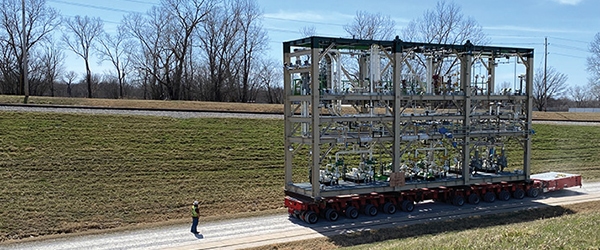
C.H. Robinson trucked parts of what will become an oil refinery to a fabricator in Oklahoma, where they were assembled into modules. Here the modules are moved down a steep hill to a nearby wharf using a self-propelled modular transporter (SPMT)—a type of trailer operated by remote control.
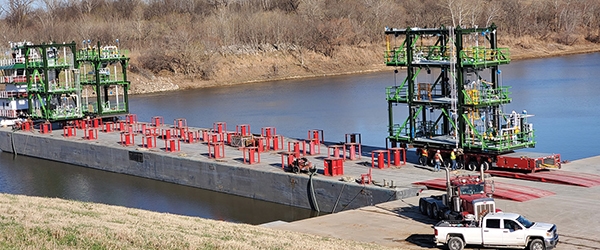
The modules are loaded onto a barge from front to back, in a carefully planned order that accounts for their different sizes and weights.
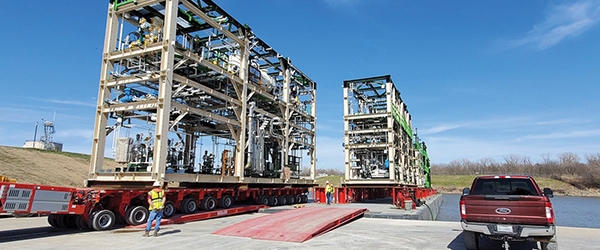
The SPMT drives right onto the barge between a series of stands, is lowered in order to rest the modules onto the stands, and then slides out—avoiding the need for a crane.
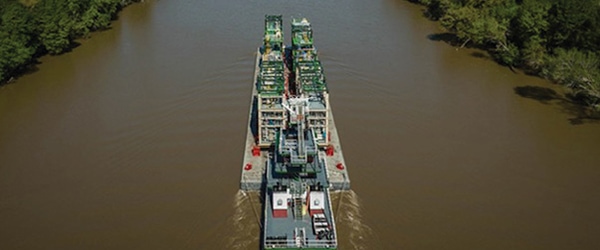
The barge with all eight modules heads from Oklahoma down a river in Louisiana on its way to the Gulf of Mexico.
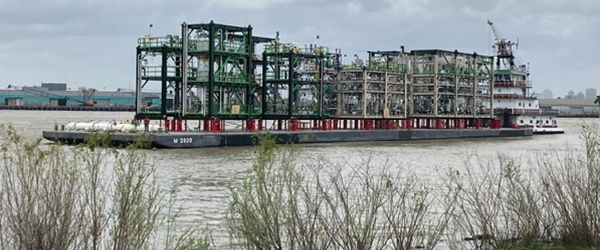
The barge arrives at the Port of Houston to transfer the cargo to a larger vessel for the next leg of its journey.
